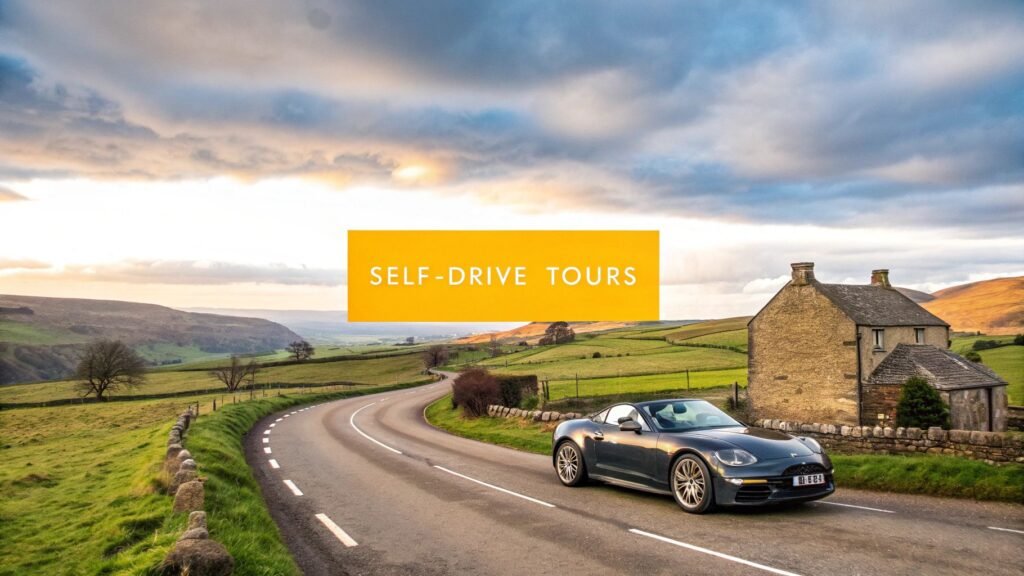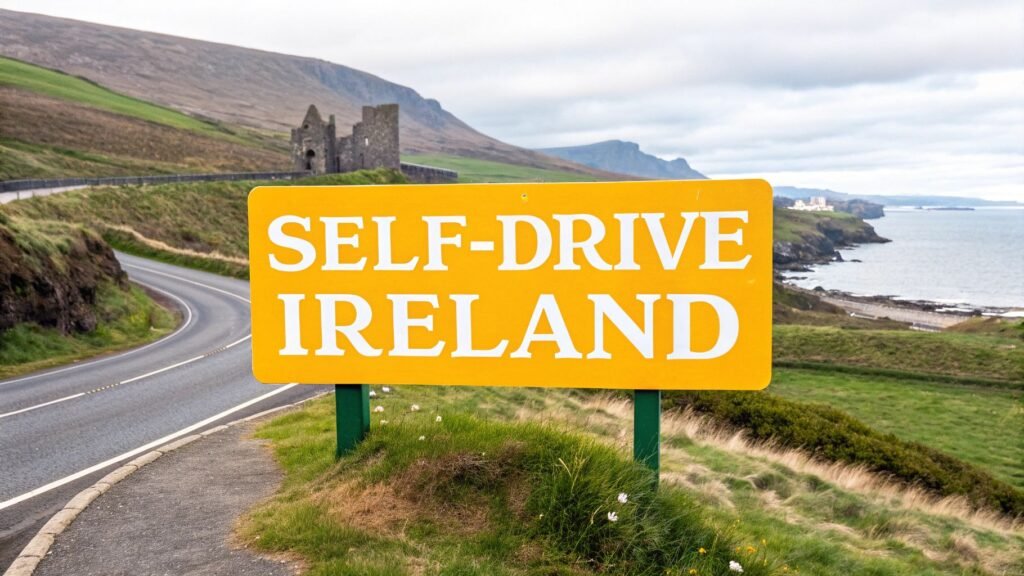A great road trip doesn't just happen the moment you turn the key. When you're gearing up for a drive from London all the way to Scotland, that upfront planning is what separates a smooth, memorable journey from a stressful one. A little time spent getting organised now will save you a world of headaches later on.
Your Essential Pre-Trip Preparation
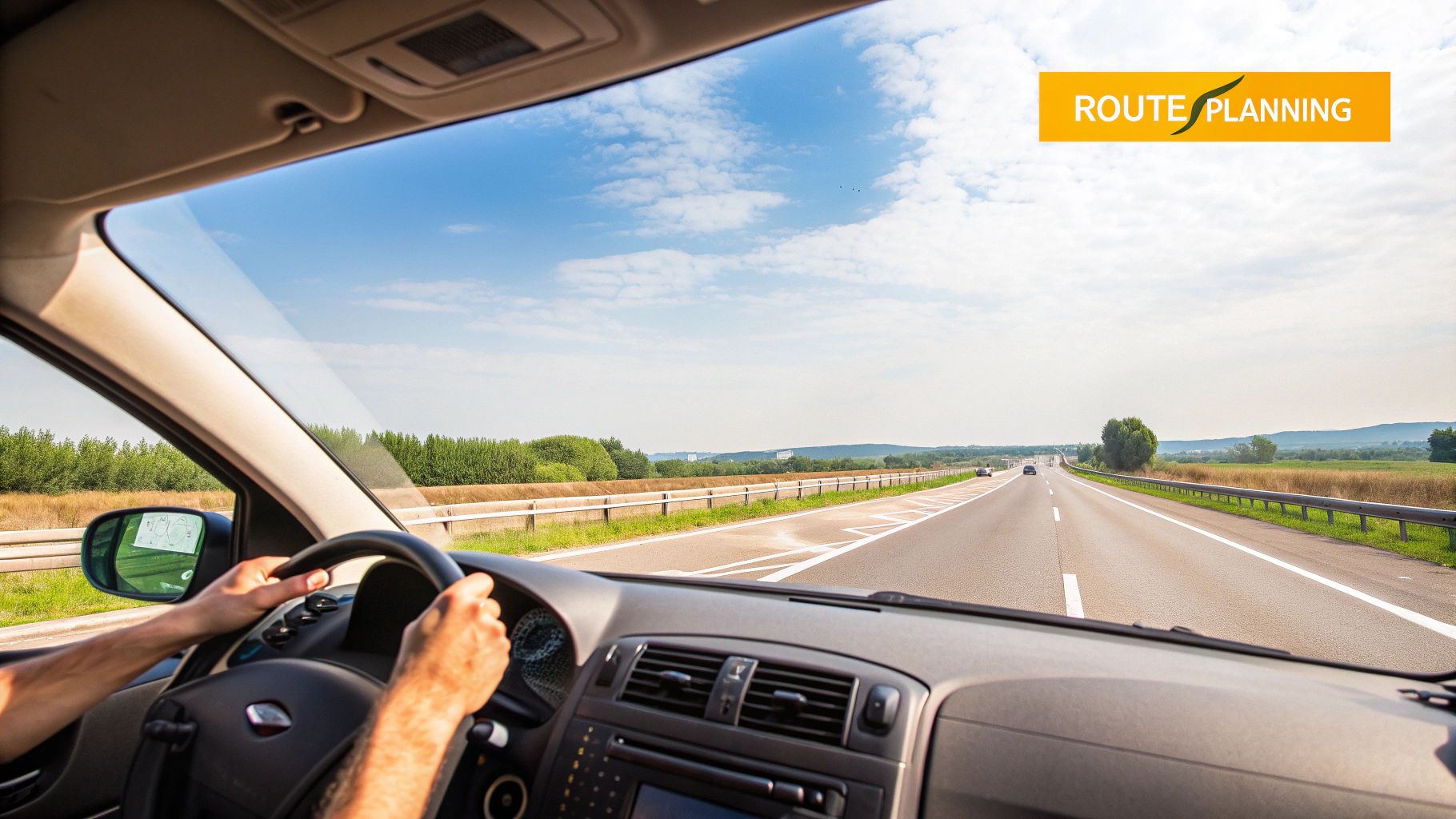
The drive north is one of Britain's iconic journeys, but enjoying it to the fullest means getting the practicalities sorted first. Let's get beyond the obvious and talk about what experienced drivers actually do before tackling a long-haul trip like this. This isn't just a checklist; it's about setting yourself up for a fantastic adventure.
Vehicle Health and Safety Checks
Before you even think about hitting the M1, giving your car a proper once-over is non-negotiable. This is your best insurance against an unscheduled, and very dull, stop on the hard shoulder of the M6 waiting for a recovery truck.
Think of it as a mini-MOT you do yourself:
- Tyres & Tread: Check the pressure on all four tyres—and don't forget the spare. The legal tread depth is 1.6mm, but for a long drive with unpredictable weather, having a bit more grip gives you real peace of mind.
- Essential Fluids: Make sure your screenwash, oil, and coolant are all topped up. You'll be glad for the full screenwash bottle when you're behind a lorry on a wet A-road, and the other two are critical for your engine's health.
- Lights & Wipers: Get someone to help you test all your lights—headlights, indicators, and brake lights. Give your wiper blades a quick inspection, too. If they look worn or leave streaks, replace them. You’re almost guaranteed to need them.
Remember, this long journey puts safety front and centre. Your destination, Scotland, has recorded around 153 road deaths and 1,931 serious injuries annually in recent years. These figures are a stark reminder of why being prepared is so important.
Plan for the Unexpected
Even the most meticulously maintained car can throw you a curveball. That's why having comprehensive breakdown cover is an absolute must. Check your policy to ensure it covers you for the entire length of your trip, including national recovery that will get you and your car home if the worst happens.
A small contingency plan can be the difference between a minor hiccup and a trip-ruining disaster. I always think through the "what-ifs"—a flat tyre, a dead battery, or even lost keys—and make sure I have a solution in mind. That peace of mind is priceless on a long drive.
As part of your planning, it's worth knowing what to do if you lose your car keys. It’s one of those things you hope never happens, but having a plan can turn a potential nightmare into a manageable problem.
Choosing the Best Driving Route for Your Trip
So, you're planning the drive from London to Scotland. The first big decision you'll make boils down to a simple trade-off: do you want speed or scenery? The two main arteries shooting north from the capital, the M6 on the West Coast and the A1/M1 combo on the East Coast, offer completely different driving personalities. Your choice here really sets the tone for the entire trip.
The journey itself is a hefty one, typically clocking in between 400 and 420 miles. Without any major stops, you're looking at 7 to 8 hours behind the wheel. You'll be joining a lot of other drivers, too—part of the 336 billion vehicle miles driven on Great Britain's roads last year. Knowing the character of each route is essential for a smooth drive. You can get a feel for the latest UK road traffic trends from the official government statistics page.
To help you decide, let's look at the two main options side-by-side.
Route Comparison London to Scotland
| Feature | West Coast Route (M6) | East Coast Route (A1/M1) |
|---|---|---|
| Primary Roads | M1, M6 | M1, A1(M) |
| Typical Drive Time | Generally faster, but prone to delays | Can be slightly longer, but often more consistent |
| Traffic | Notorious for congestion around Birmingham & Manchester | Usually less congested, especially north of Peterborough |
| Scenery | Mostly functional until Cumbria's dramatic fells appear | Historic route with rolling fields and easier scenic detours |
| Key Detours | The Lake District, Peak District (western side) | York, Durham, Northumberland Coast, Yorkshire Dales |
| Best For | Drivers on a tight schedule or those making a beeline for the Lakes | History buffs and those wanting a more relaxed, scenic journey |
Ultimately, there’s no single "best" route; it all depends on your priorities for the journey.
The West Coast Route: The M6 Sprint
If getting to Scotland as quickly as possible is your main goal, the M6 is usually your best bet. It’s the workhorse of British motorways, carving a direct path past major hubs like Birmingham and Manchester. It's built for efficiency.
The trade-off? Traffic. The M6 is infamous for its bottlenecks and congestion, especially around the big cities. The scenery is also fairly unremarkable for the first few hours, but don't write it off completely. Once you get north of Lancaster, the landscape transforms dramatically as the motorway slices through the stunning Cumbrian Fells, giving you a proper taste of the wilder north.
The East Coast Route: The A1(M) Scenic Ramble
For a more relaxed and arguably more interesting drive, the A1(M) is a fantastic alternative. This route roughly follows the historic Great North Road, so it feels steeped in a bit more history. The journey takes you through flatter, more agricultural landscapes.
While parts of the A1 aren't a full three-lane motorway, I've often found it to be a less stressful drive than the M6. It also offers much easier access to incredible historic cities like York and Durham, which are perfect for breaking up the journey.
My Personal Takeaway: Don't treat this drive as just a means to an end. The journey is part of the holiday. Building in a scenic detour, even for just an hour or two, can completely change the experience. Pulling off the motorway to explore the Yorkshire Dales or the Peak District turns a long slog into a mini-adventure.
Planning Your Scenic Detours
The real magic of a UK road trip is in the stops. If you have an extra day or even just a few hours to spare, weaving one of these into your plan is well worth it:
- The Peak District: Easily reached from the M1. It’s a fantastic place for rugged moorlands and postcard-perfect villages. Stopping in Bakewell for an authentic tart is practically a rite of passage.
- The Yorkshire Dales: A brilliant detour from either the A1(M) or the M6. Think stunning limestone landscapes, iconic dry stone walls, and deep valleys perfect for a quick leg-stretch.
- The Lake District: This is an absolute must-see if you're taking the M6. Even a short drive around Lake Windermere or a stop in the charming village of Grasmere will be a major highlight of your trip.
This freedom to explore is exactly what makes self-drive tours so rewarding. You get to set your own pace and uncover those hidden gems that make a trip unforgettable.
Before you go, a quick word on packing. It's easy to underestimate how much space everything takes.
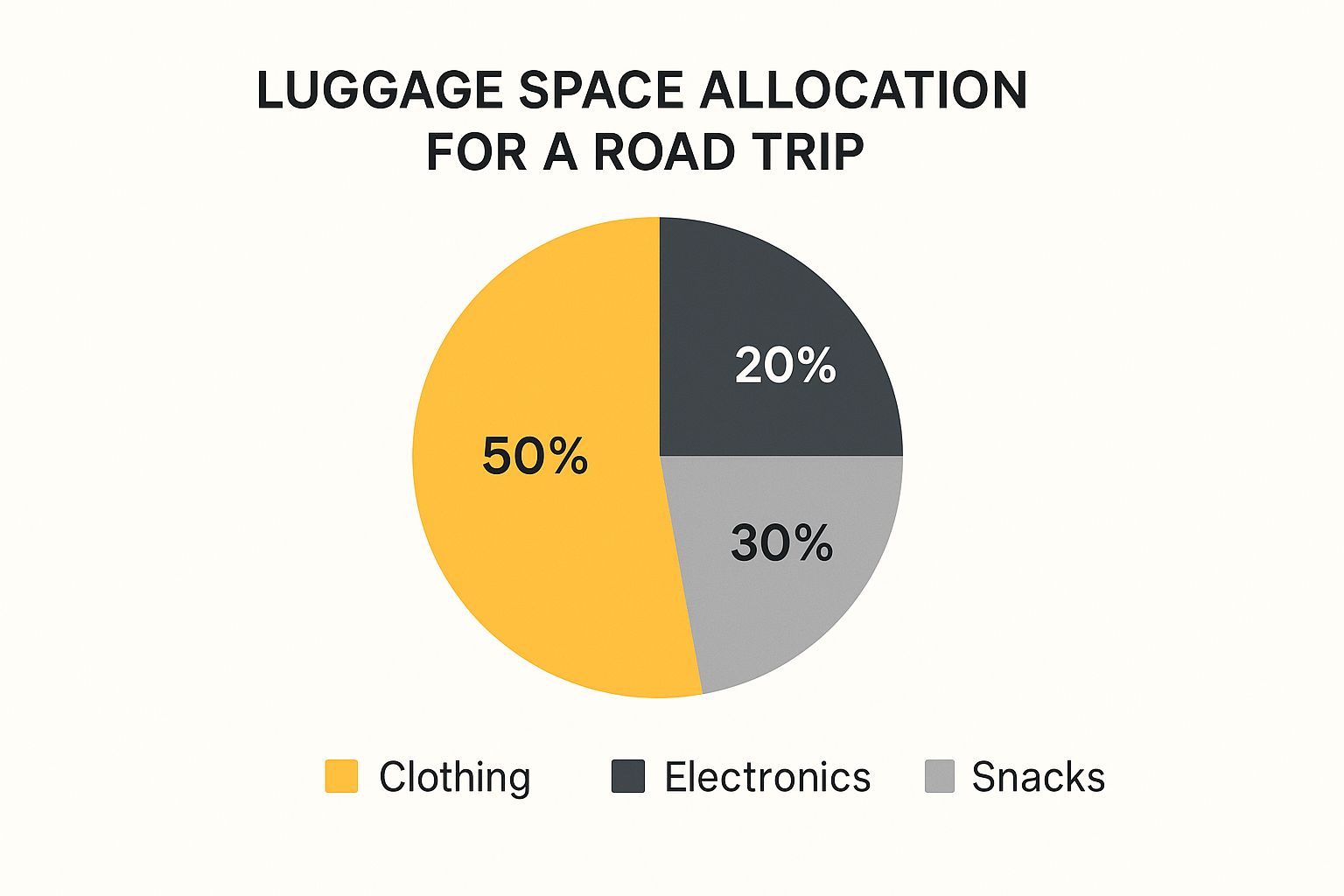
As you can see, things like snacks and electronics can eat up a surprising amount of room. A little bit of smart packing goes a long way to ensuring a comfortable and clutter-free journey.
Uncovering Memorable Stops And Detours
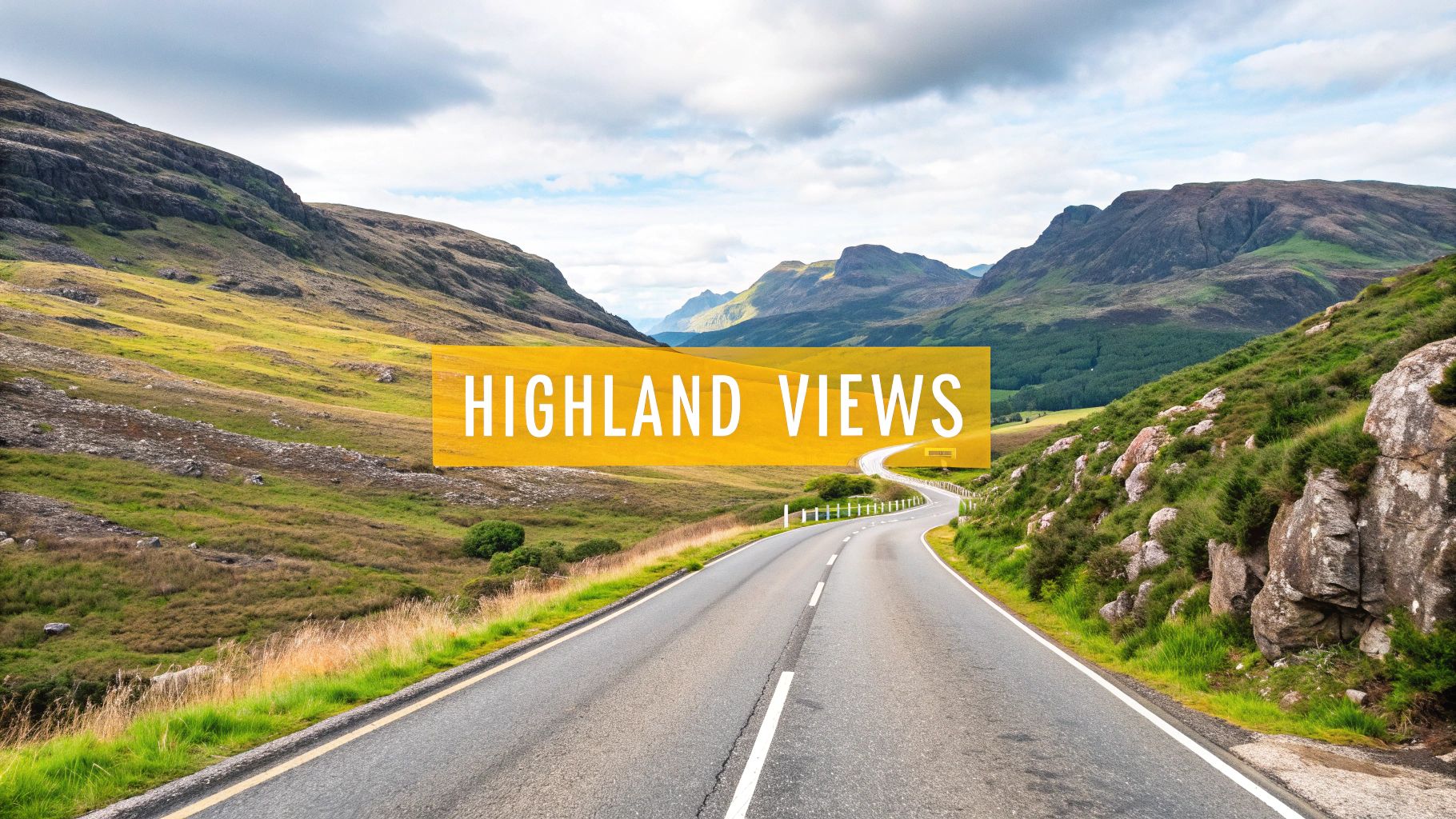
Let's be honest: the drive from London to Scotland is a long haul. But thinking of it as just a tedious motorway slog is a huge missed opportunity. The secret to making this journey a highlight, rather than a test of endurance, is to embrace the stops.
This isn't about pulling into a soulless service station for a sad sandwich and a lukewarm coffee. It's about turning the drive itself into part of the adventure. You're cutting right through the heart of Britain, and with a little planning, you can easily dip into centuries of history or stunning natural landscapes. A well-chosen break, even a short one, can completely reset your mood and make the whole experience infinitely more rewarding.
East Coast Treasures Along The A1(M)
If you’ve decided on the East Coast route, you're in for a treat. This path is steeped in history, and the crown jewel of the journey is undoubtedly the city of York. It’s just a quick detour off the A1(M) and is well worth your time.
Even if you only have a couple of hours to spare, you can get a real taste of the city:
- Walk the Shambles: Get lost in the famous medieval street with its crooked, overhanging timber-framed houses. It honestly feels like you’ve stepped onto a film set.
- Marvel at York Minster: You don’t even need a ticket to go inside. Just standing outside and taking in the sheer scale of this magnificent cathedral is an experience in itself.
- Stroll the City Walls: A quick walk along a section of the ancient walls gives you a brilliant perspective on the city and some fantastic photo opportunities.
A little further north, Durham is another fantastic option. Its cathedral and castle, a designated UNESCO World Heritage Site, are perched dramatically on a hill above the River Wear. Durham is more compact than York, making it the perfect spot for a shorter, one-hour leg stretch to grab a coffee in the charming market square.
Natural Wonders Off The M6
Taking the M6 up the West Coast? The real magic begins once you get past Lancashire. The scenery starts to transform, and you’ll soon see signs for the Lake District National Park. Don't dismiss this as too much of a detour—it’s an iconic slice of England that’s surprisingly accessible.
Don't be intimidated by the idea of a major detour. The main artery of the Lake District, Windermere, is only about a 30-minute drive from the M6 at Junction 36. You can be lakeside, soaking in the views, in less time than a typical service station lunch break.
A quick visit could mean a drive along the shores of Lake Windermere, a stop in the bustling village of Ambleside, or a chance to grab some world-famous gingerbread in Grasmere. The contrast between the tranquil water and the dramatic fells is the perfect antidote to motorway monotony.
Exploring Hadrian's Wall
As you close in on the Scottish border, you have an incredible opportunity to come face-to-face with Roman history. Hadrian's Wall, an epic fortification that once stretched 73 miles from coast to coast, is just a stone's throw from your route.
You can easily reach it from the A69, which runs parallel to the M6 in this part of the country. You don't need to commit to a multi-day hike, either. Pulling over at a site like Housesteads Roman Fort or the famous Sycamore Gap lets you walk along a preserved section of the wall, touch stones laid down nearly 2,000 years ago, and absorb the wild, windswept beauty of the Northumberland landscape.
It's a powerful and unforgettable way to mark your crossing from England into Scotland. These are the kinds of experiences that elevate a simple road trip into something special. Once you arrive, the capital city itself offers a wealth of history. Get inspired for your arrival by reading our guide to Edinburgh, the Athens of the North.
Navigating Scottish Roads Like a Local
https://www.youtube.com/embed/K11S1S4C1qA
Once you cross that border into Scotland, you'll feel the entire character of the drive shift. The familiar motorways start to peel away, replaced by A-roads and, eventually, the legendary single-track lanes that snake through the Highlands. To really enjoy the spectacular landscapes safely, you'll need to adapt your driving. This is less about the official rules of the road and more about understanding the unwritten local etiquette.
The biggest adjustment for most drivers is getting the hang of single-track roads. These are exactly what they sound like: narrow lanes, often with a strip of grass growing right down the middle, and they're everywhere in the Highlands and Islands. The whole system hinges on the proper use of passing places—small pull-ins carved out on the side of the road.
The rule of thumb is pretty simple: the car closest to a passing place on their side of the road should pull in to let the oncoming vehicle pass. If the passing place is on your right, you stop opposite it, giving the other driver room to pull into it. Don’t forget a friendly wave; it’s customary and goes a long way.
Understanding Passing Place Etiquette
Driving these roads is a dance, a cooperative effort, not a race. You have to constantly look well ahead, anticipating traffic around blind corners and over the crests of hills. It's all about being prepared to stop.
Keep these pointers in mind for a smooth journey:
- Never, ever park in a passing place. They are essential for keeping traffic flowing, not for a quick photo op.
- Let faster locals pass. If a car comes up behind you and clearly knows the road better, pull into the next passing place and wave them on. It avoids building up a frustrated queue.
- Don't create a convoy. If you're traveling with friends in another car, leave a generous gap between you. This allows oncoming traffic to navigate past one vehicle at a time instead of facing a long, intimidating line.
This system is remarkably efficient when everyone plays their part. It’s all about courtesy and thinking ahead.
Dealing with Weather and Wildlife
Scottish weather is notoriously fickle. It’s no cliché—you really can get brilliant sunshine, dense fog, and a sudden downpour all in one afternoon. Always drive with your headlights on in poor visibility and be prepared for your speed to plummet, especially in the glens where mist can hang around for hours.
Wildlife is the other big factor on rural roads. You're almost certain to see deer, particularly around dawn and dusk. When you see a “Red Deer Crossing” sign, take it seriously. A run-in with a large stag can cause an incredible amount of damage to both your car and its occupants.
And then there are the sheep. They wander freely on unfenced roads and have absolutely zero road sense. In misty conditions, they can be surprisingly hard to spot. Slow right down and give them a very wide berth.
Fuel and Planning in Remote Areas
Once you get into the more remote parts of the Highlands and Islands, petrol stations become a rare sight. Many aren't open 24/7, a stark contrast to the abundant services you get used to on the drive up from London.
I live by one simple rule here: never let your tank drop below half full. When you see a petrol station in a village like Fort William or Ullapool, just top it up. This small habit provides a huge safety net. It gives you the freedom to take that intriguing-looking side road without the nagging worry of getting stranded. Honestly, it’s what gives you the confidence to truly embrace the adventure of the open Scottish road.
Finding the Right Accommodation Along Your Route
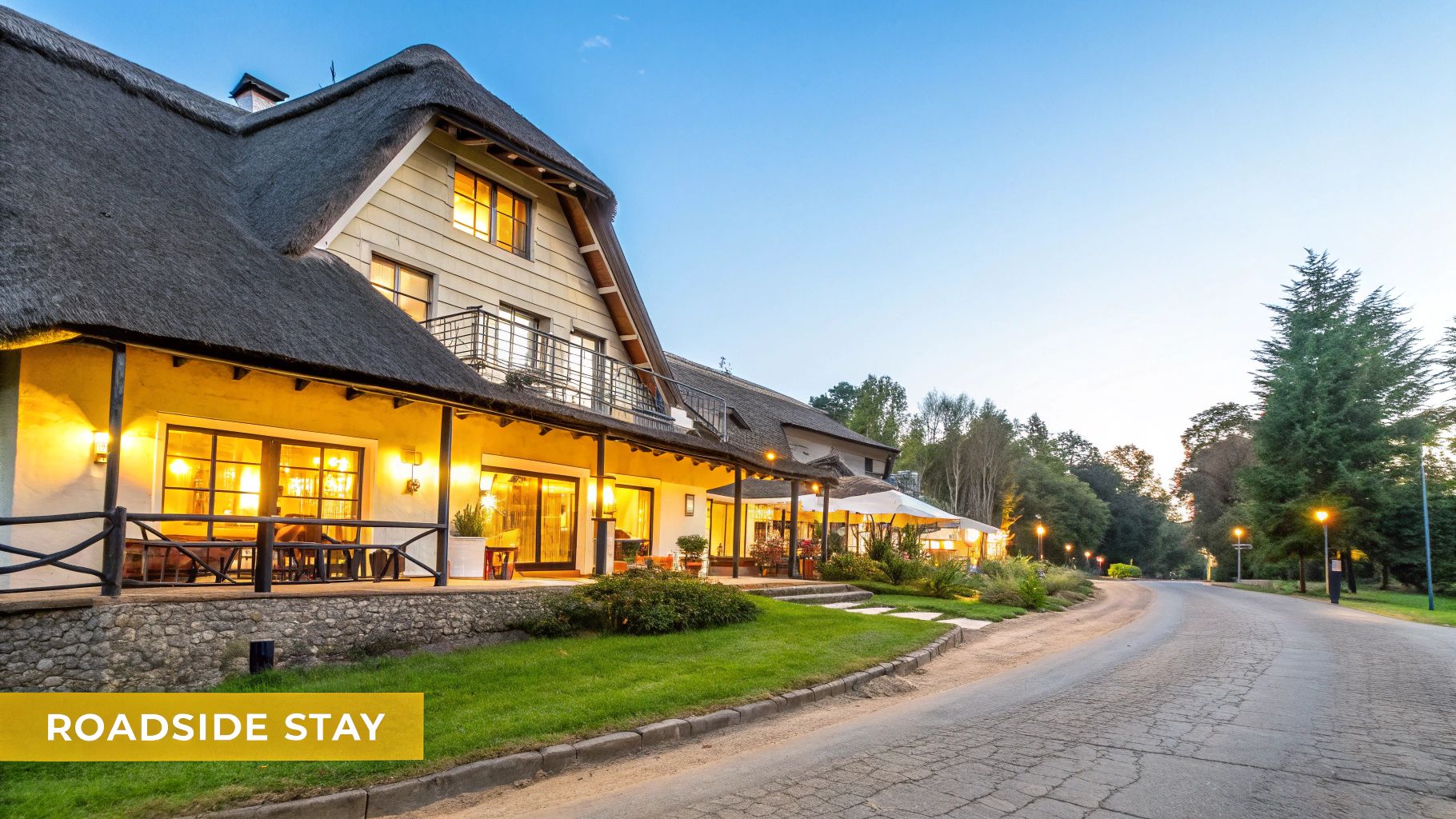
Where you choose to rest your head can absolutely make or break a road trip. It’s not just about finding a bed for the night. The right stopover is a chance to recharge your batteries, soak up a bit of local culture, and turn the long drive from London into part of the adventure.
Ultimately, your choice boils down to what you value most on this leg of the journey: pure efficiency, sticking to a budget, or creating a memorable experience. Are you just looking to crash before hitting the road at dawn, or do you want your overnight stop to feel like a mini-holiday?
Roadside Hotels for Efficiency
For pure, unadulterated convenience, you really can't go wrong with the well-known hotel chains peppered along major motorways like the M6 or A1(M). Think Premier Inn or Holiday Inn Express—they're reliable, generally affordable, and perfectly placed for a no-fuss stop.
The main advantage here is simplicity. You pull off the motorway, park easily, and check in without having to navigate a confusing town centre after a long day behind the wheel. The downside? They can feel a bit soulless and completely disconnected from the charm of the region you're passing through.
My Personal Tip: Don't just assume you can roll up and get a room. These places, especially on a Friday night or during school holidays, get booked up fast by people doing the exact same trip. Book ahead to avoid disappointment or inflated last-minute prices.
B&Bs and Inns for Local Charm
If you’ve built a little extra time into your schedule, I highly recommend detouring into a historic market town or a quiet village for the night. Staying at a traditional Bed & Breakfast or an old coaching inn offers a completely different vibe. You'll get a genuine feel for the area, and nothing beats a proper, home-cooked breakfast to set you up for the next day's drive.
This is the perfect approach if you’re planning to stop somewhere like York, the Lake District, or a town in the beautiful Yorkshire Dales. It turns a simple overnight stay into a real experience. You'll have to drive a bit off your main route and parking can sometimes be tricky on narrow streets, but the payoff in character and hospitality is almost always worth it.
For those planning a more extensive trip, looking at a pre-planned itinerary like a Taste of Scotland 8-day self-drive tour can give you fantastic ideas for the kinds of charming spots that make a holiday special. Breaking up the driving to Scotland from London by staying somewhere lovely in Northern England doesn't just make the drive easier; it makes the entire journey better.
Answering Your London to Scotland Driving Questions
Even the most seasoned road-tripper has a few lingering questions before hitting the road. It's only natural. This drive is a big one, so let's tackle some of the common queries I hear all the time. Getting these details sorted will help you feel completely prepared for the journey ahead.
We've gathered some of the most frequently asked questions about the drive right here. Think of this as your quick-reference guide for those last-minute details.
FAQ Quick Answers
| Question | Answer |
|---|---|
| How long is the drive? | Around 8-10 hours of pure driving time, depending on your exact route and destination. |
| What's the best route? | The M1/M6 route is fastest, while the A1(M) offers a more scenic alternative along the east coast. |
| Can I do it in one day? | Yes, it's definitely possible if you start early. However, an overnight stop makes it much more enjoyable. |
| Do I need to book accommodation in advance? | Highly recommended, especially during peak seasons or if you have specific places you want to stay. |
Now that we've covered the basics, let's get into a bit more detail on the big questions.
What's This Trip Going to Cost Me?
This is always the million-dollar question, isn't it? The final bill really comes down to your car and your travel preferences. Your biggest expenses will be fuel, any tolls you decide to pay, and a place to sleep if you’re not doing it all in one go.
Let's break it down:
- Fuel: For an average car, you're probably looking at £70 to £100 in petrol or diesel for the one-way trip. This can swing wildly based on your car's MPG and what the pumps are charging that week.
- Tolls: The most direct routes have toll options. The M6 Toll is a classic example. It'll set you back about £8-£9 for a car on a weekday, but honestly, it can be money well spent to dodge the gridlock around Birmingham.
- Accommodation: A simple roadside hotel like a Premier Inn or Travelodge will typically run £60-£120. If you fancy something with a bit more character, a local B&B might cost a little more.
A good starting point for your budget would be somewhere in the £150-£250 range for the one-way drive itself. That doesn't include your food, coffee stops, or any fun activities along the way.
Is Driving in Winter a Bad Idea?
Not at all, but you absolutely have to be prepared. The major motorways like the M6 and A1(M) are top priority for gritting and are usually kept clear and safe. The real test begins once you get further north.
The challenge isn't the motorway; it's the smaller roads. If you're heading into the Highlands or rural areas once you arrive in Scotland, that's where things get tricky. Snow and black ice can make these routes treacherous, and some can even be closed without much warning. Always, always check the forecast and live traffic reports from a source like Traffic Scotland before you set out.
If you’re driving to Scotland from London in the winter months, make sure your car is ready. Good all-season or winter tyres are non-negotiable, and your screenwash needs to be a high-concentration, anti-freeze formula. Trust me, you don't want it freezing over when a lorry sprays you with slush.
When Should I Leave London for the Best Start?
My advice is always the same: get up and go early. Leaving London between 6:00 AM and 7:00 AM is the sweet spot.
You'll sail past the worst of the city's infamous rush hour, which can easily save you an hour or two of sitting in traffic and a whole lot of frustration. Starting early also means you'll do most of the drive in daylight, which is not only safer but also lets you actually see the countryside you're driving through. It gives you the freedom to take that spontaneous detour to a castle or scenic viewpoint without worrying about arriving in the pitch black.
Ready to turn your road trip plan into a reality? At BTOURS, we specialize in creating unforgettable self-drive tours that let you explore the UK and beyond at your own pace. Discover our curated journeys and find your perfect adventure at https://www.btours.com.


